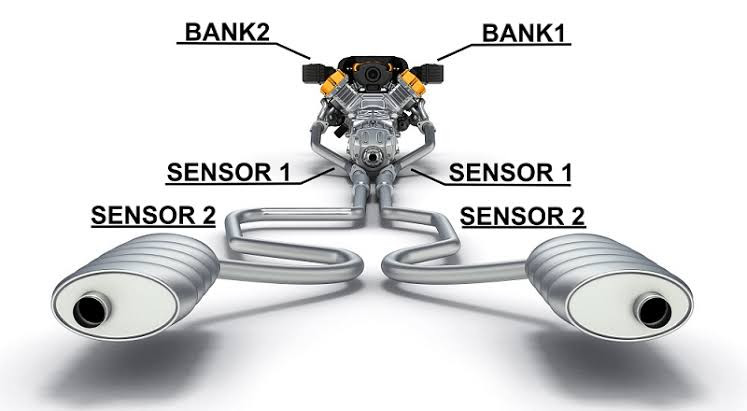"The difference between a professional mechanic and a novice isn't just experience, it's knowing the right shortcuts."
This insight from my 20+ years in automotive repair perfectly captures why oxygen sensor identification frustrates so many DIYers. A simple diagnosis turns into hours of confusion and potentially costly mistakes. Today, I'm sharing the foolproof method professionals use to identify oxygen sensor banks with absolute certainty.
Understanding Oxygen Sensor Basics
Oxygen sensors (O2 sensors) are critical components that measure the oxygen content in your vehicle's exhaust gases. These sensors help your engine's computer maintain the optimal air-fuel ratio, ensuring efficient performance, reduced emissions, and improved fuel economy.
Modern vehicles typically have multiple oxygen sensors positioned at strategic locations in the exhaust system. They're commonly referenced using two key terms:
- Banks - Refers to the grouping of cylinders on each side of the engine
- Sensor numbers - Indicates the position of sensors relative to the engine
When your check engine light illuminates with an oxygen sensor code like "P0420 Bank 1" or "P0136 Bank 2 Sensor 2," correctly identifying which sensor needs attention is crucial. Replacing the wrong sensor wastes time and money.
The Bank and Sensor Numbering System
Let's breakdown what these terms actually mean:
Banks
- Bank 1 - The side of the engine containing cylinder #1
- Bank 2 - The opposite side of the engine
For V-engines (V6, V8, etc.), there's one bank on each side of the "V" configuration. For inline engines (I4, I6), there's typically only Bank 1, though some diagnostics may still reference Bank 2.
Sensor Numbers Explained
- Sensor 1 - The upstream sensor located before the catalytic converter (closest to the engine)
- Sensor 2 - The downstream sensor located after the catalytic converter (further away from the engine)
Some high-performance or emissions-focused vehicles may have additional sensors (Sensor 3, Sensor 4), particularly with multiple catalytic converters.
The Common Confusion
Here's where things get tricky. Many amateur guides simplistically state that "Bank 1 is always on the driver's side" or "Bank 1 is always on the passenger side." This is dangerously incorrect! Bank configuration varies dramatically among manufacturers and engine designs.
For example:
- On a Ford V8, Bank 1 might be on the passenger side
- On a BMW V6, Bank 1 might be on the driver's side
- On a Subaru flat-four, the banks are arranged front-to-back rather than side-to-side
No wonder people get confused!
The Foolproof Professional Method
After years of watching fellow mechanics and DIY enthusiasts struggle with this issue, I can share the absolute simplest, most reliable method for identifying sensor banks:
- Connect a diagnostic scan tool to your vehicle's OBD-II port
- Clear any existing diagnostic codes
- Unplug ONE oxygen sensor connector (any one will do)
- Turn the ignition on (engine running optional)
- Scan for new codes with your diagnostic tool
The resulting code will specifically identify which bank and sensor position you just unplugged!
If you see "P0131 Bank 1 Sensor 1 Circuit Low Voltage," you've just definitively identified the Bank 1 Sensor 1 location. If you see "P0156 Bank 2 Sensor 2 Circuit Malfunction," you know precisely which sensor you unplugged.
This method eliminates all guesswork and works universally across vehicle makes and models. It's what the professionals use when service manuals are unavailable.
Alternative Identification Methods
If you don't have access to a scan tool, here are other approaches (though less reliable):
Method 1: Identifying Cylinder #1
Since Bank 1 contains cylinder #1, locating this cylinder can help identify Bank 1. Look for:
- Engine timing marks
- Firing order diagrams on the intake manifold
- Service manual cylinder numbering
Method 2: Check Exhaust Manifold Design
On V-engines, examine how the exhaust manifolds connect to the exhaust pipes. The side with the earliest connection point to the catalytic converter often (but not always) corresponds to Bank 1.
Method 3: Consult Vehicle-Specific Information
Always the safest alternative to the scan tool method:
- Factory service manuals
- Manufacturer websites
- Model-specific forums
Real-World Application
Let's say your car shows the error code "P0420 Bank 1 Catalyst Efficiency Below Threshold." Before replacing expensive components, you'd want to check both oxygen sensors on Bank 1—but which side is that?
Using our foolproof method:
- Connect your scan tool
- Clear codes
- Unplug one oxygen sensor
- Turn on the ignition
- Check for new codes
If you get "P0131 Bank 1 Sensor 1 Circuit Low," you now know exactly which side is Bank 1. Replace the sensors on that side first before considering a catalytic converter replacement.
Proper oxygen sensor function is crucial for:
- Fuel efficiency - A faulty oxygen sensor can reduce MPG by up to 40%
- Emissions control - Critical for passing inspection and environmental protection
- Engine performance - Prevents hesitation, rough running, and power loss
- Catalytic converter protection - Prevents damage to this expensive component
According to AutoZone research, oxygen sensor-related issues account for nearly 15% of all check engine light illuminations. Knowing how to correctly identify these components can save significant time and money.
Final Thoughts
As a professional mechanic, I've seen countless cases where vehicle owners replaced the wrong oxygen sensor multiple times, wasting hundreds of dollars and hours of frustration. This foolproof identification method eliminates that risk entirely.
Remember: unplug, scan, identify. It's that simple. This approach works across virtually all makes and models, making it the universal solution to oxygen sensor identification.
The next time you face an oxygen sensor-related code, skip the guesswork and use this professional technique. Your wallet, and your sanity will thank you.

Comments (0)
Please login to join the discussion
Be the first to comment on this article!
Share your thoughts and start the discussion